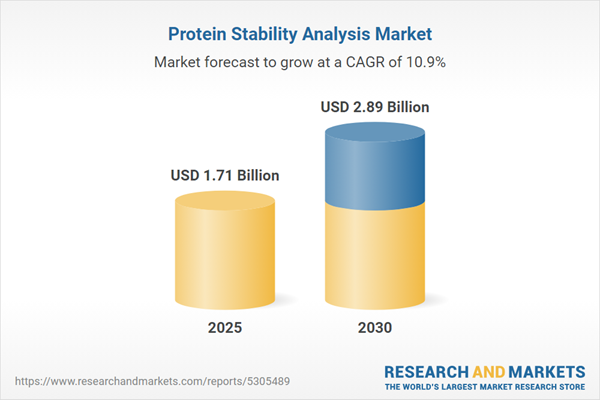Speak directly to the analyst to clarify any post sales queries you may have.
The Protein Stability Analysis Market is experiencing robust demand as organizations in biopharmaceuticals and life sciences intensify their focus on drug development efficiency, regulatory compliance, and product quality. As market complexity increases, reliable protein stability workflows have become foundational for sustaining competitive advantage.
Market Snapshot: Protein Stability Analysis Market Growth and Opportunity
The global Protein Stability Analysis Market grew from USD 1.55 billion in 2024 to USD 1.71 billion in 2025. It is projected to maintain a steady upward trajectory at a CAGR of 10.86%, reaching USD 2.89 billion by 2030. This expansion is driven by evolving demands in drug development, advancements in analytical technologies, and increasing biopharmaceutical R&D investments among key end users. Market participants are responding with technological innovation and strategic service expansion, ensuring enhanced stability characterization across a widening spectrum of therapeutic proteins.
Scope & Segmentation
- Offering: Consumables, Instruments, Reagents & Assay Kits, Services, Software
- Technique: Chemical & Conformational Stability including Chromatography-Based Techniques, Dynamic Light Scattering (DLS), Mass Spectrometry, Spectroscopy Techniques, Thermal Stability Analysis such as Differential Scanning Calorimetry (DSC), Differential Scanning Fluorimetry (DSF)
- Protein Type: Biosimilars, Enzymes, Fusion Proteins, Hormones & Cytokines, Monoclonal Antibodies (mAbs), Peptides, Recombinant Proteins, Vaccines
- Application: Drug Discovery & Development, Lead Optimization, Protein Engineering, Target Identification & Validation, Formulation & Manufacturing, Biopharmaceutical Production, Formulation Development, Research activities including Enzyme Stability and Protein Folding Studies, Testing & Validation such as Quality Control, Diagnostics, and Stability Testing
- End User: Academic & Research Institutes, Contract Research Organizations (CROs), Diagnostic Labs, Food & Beverage Industry, Pharmaceutical & Biotechnology Companies
- Geographical Coverage: Americas (including North America and Latin America), Europe, Middle East & Africa, and Asia-Pacific (with detailed coverage of the United States, Canada, Brazil, Germany, China, India, Japan, and other key national markets)
- Companies Analyzed: Thermo Fisher Scientific Inc., Danaher Corporation, Agilent Technologies, Waters Corporation, Merck KGaA, Bio-Rad Laboratories, PerkinElmer, Shimadzu Corporation, Malvern Panalytical (Spectris PLC), Bruker Corporation, NanoTemper Technologies, Sartorius AG, Unchained Labs, ProtaGene, Charles River Laboratories, HORIBA, Enzo Biochem, Aragen Life Sciences, KEP TECHNOLOGIES SA
Key Takeaways
- Real-time, high-resolution analytical methods and machine learning models are enabling rapid and predictive assessments of protein stability, accelerating biotherapeutic design cycles.
- Automation and digital integration are scaling throughput, reducing resource consumption, and supporting collaborative workflows across geographically dispersed teams.
- Regulatory dynamics drive continuous improvement in assay validation and quality assurance processes, influencing strategic investments in instrumentation and informatics.
- Segment diversity reflects the nuanced needs of pharmaceutical, CRO, and research organizations—each employing specific techniques to address unique challenges from formulation development to diagnostics.
- Regional markets exhibit distinct drivers: Americas lead in technology adoption; Europe, Middle East & Africa emphasize quality and compliance; Asia-Pacific shows rapid growth in contract research and manufacturing capacity.
- Flexible service models, including a mix of in-house and outsourced workflows, allow organizations to balance proprietary expertise with operational scalability.
Tariff Impact on Protein Stability Analysis Supply Chains
Recent United States tariff measures have significantly impacted global sourcing of analytical equipment and consumables. Organizations have responded by renegotiating supply contracts, emphasizing domestic sourcing, and reengineering procurement strategies to minimize cost volatility. Adaptive inventory management and protocol optimization have helped laboratories control expenses and sustain continuity amid shifting trade policies.
Methodology & Data Sources
This report is based on extensive secondary research and expert interviews, synthesizing peer-reviewed literature, industry white papers, vendor documentation, and conference proceedings. Data triangulation and cross-verification with senior decision-makers in the field ensure that trends and segmentation insights are robust and actionable.
Why This Report Matters
- Equips leaders with a detailed analysis of technology landscape shifts, supply chain pressures, and competitive positioning in the Protein Stability Analysis Market.
- Supports informed investment, procurement, and partnership decisions with region- and segment-specific insights.
- Provides actionable recommendations for workflow optimization, regulatory alignment, and market entry strategies.
Conclusion
Protein stability analysis is fundamental for biopharmaceutical innovation, regulatory compliance, and efficient production. Organizations that integrate advanced analytical tools and responsive supply models will be well positioned to capitalize on market trends and ensure product integrity across increasingly complex pipelines.
Additional Product Information:
- Purchase of this report includes 1 year online access with quarterly updates.
- This report can be updated on request. Please contact our Customer Experience team using the Ask a Question widget on our website.
Table of Contents
3. Executive Summary
4. Market Overview
7. Cumulative Impact of Artificial Intelligence 2025
Companies Mentioned
The companies profiled in this Protein Stability Analysis market report include:- Thermo Fisher Scientific Inc.
- Danaher Corporation
- Agilent Technologies, Inc.
- Waters Corporation
- Merck KGaA
- Bio-Rad Laboratories, Inc.
- PerkinElmer, Inc.
- Shimadzu Corporation
- Malvern Panalytical Ltd by Spectris PLC
- Bruker Corporation
- NanoTemper Technologies
- Sartorius AG
- Unchained Labs
- ProtaGene, GmbH
- Charles River Laboratories International, Inc.
- HORIBA, Ltd.
- Enzo Biochem, Inc.
- Aragen Life Sciences Ltd.
- KEP TECHNOLOGIES SA
Table Information
| Report Attribute | Details |
|---|---|
| No. of Pages | 186 |
| Published | October 2025 |
| Forecast Period | 2025 - 2030 |
| Estimated Market Value ( USD | $ 1.71 Billion |
| Forecasted Market Value ( USD | $ 2.89 Billion |
| Compound Annual Growth Rate | 10.8% |
| Regions Covered | Global |
| No. of Companies Mentioned | 20 |









